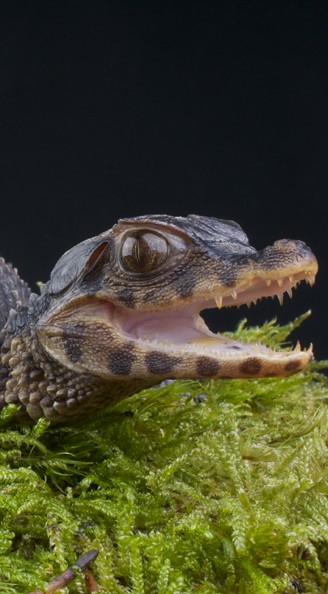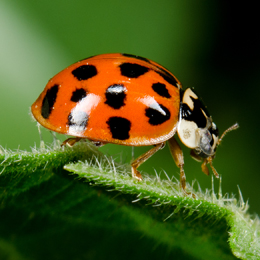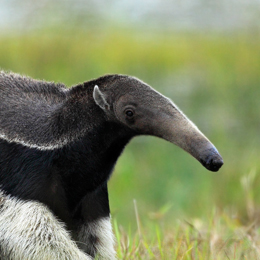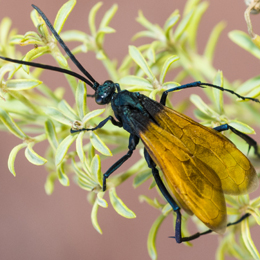Physical Characteristics
Found primarily along the upper Amazon River, the Cuvier’s dwarf caiman maintains a relatively small body. Where males exhibit an average length of 1.3 - 1.5 meters, females can grow till 1.25 meters. Their average body mass is about 6 - 7 kg depending upon the age of the caiman and its nutrition in the wild.
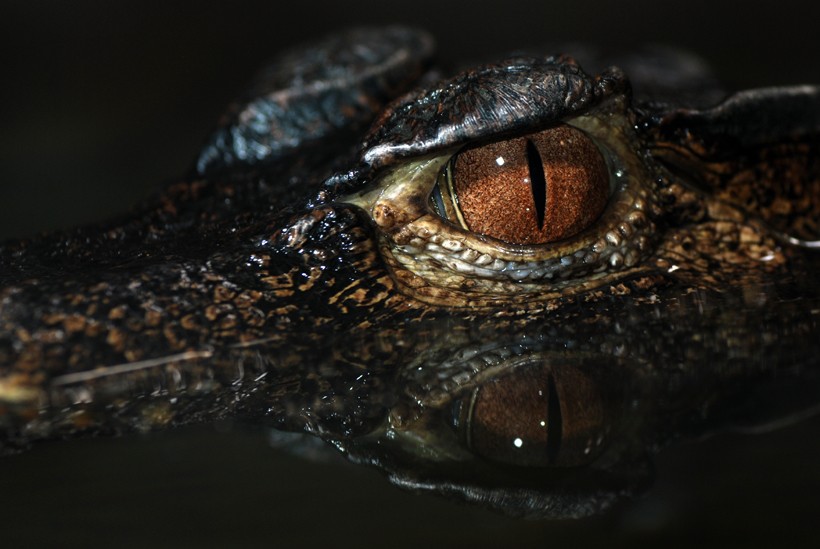
Most Cuvier’s dwarf caimans portray brown pupils
?
Image credits: Jason Mintzer/Shutterstock
Showcasing a reddish-brown color on their scaly bodies, the largest specimen recorded till date maintains a maximum length of 1.7 meters (5 ft). Despite being the smallest living new world crocodilian, the species preserves a dominantly armored body, a slender neck, and bilateral symmetry.
Habitat & Geographical Distribution
The Cuvier’s dwarf caiman prefers freshwater rivers, lakes and ponds mainly inhabiting riparian beds along the Amazon basin. They follow channels leading into shallow forest streams generally avoiding salty/briny waters. Nocturnal by nature, these dwarf caimans are more active at night and can often be found lurking across marshy grounds. They are freshwater species that prefer fast moving streams or rapids in forested areas. The exposed shorelines of Bolivia, particularly around dead wood patches are also breeding grounds for many dwarf caimans.
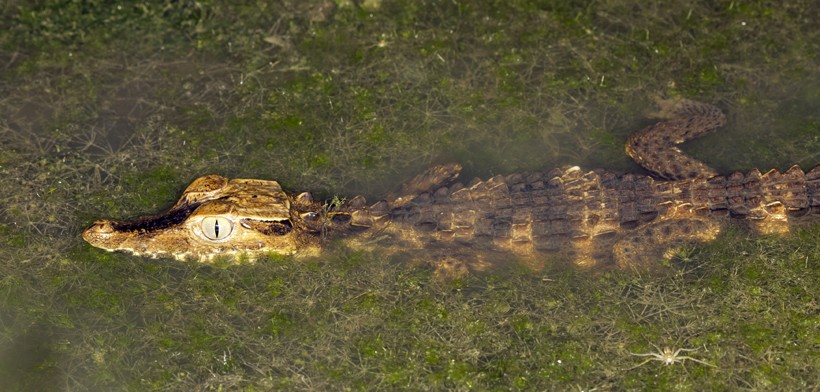
Cuvier's dwarf caimans are often found in shallow forest streams
?
Image credits: Dr. Morley Read/Shutterstock
Incredibly terrestrial, the species prefers cool temperatures inhabiting the flooded forests of the Amazon basin. While nutrient-poor waters of regions like Venezuela and south-east of Brazil make excellent habitats for the species, they have also been found in the Savanna grasslands of Orinoco and eastern Paraguay. Cuvier’s dwarf caiman is known to occupy streams of different sizes, spotted primarily near the shores, resting on top of rocks with their back exposed on the surface and head facing the sun.
Cuvier’s dwarf caiman is native to central and tropical northern South America. Their distribution ranges from the Orinoco River, Amazon River and the Sao Francisco River till the upper water beds of the Paraguay River. They can also be found in gallery forests or the savannah grasslands of Columbia, Peru, Ecuador, Venezuela, Uruguay, Guyana, Surinam, French Guiana, Bolivia and Brazil.
Anatomy
The Cuvier’s dwarf caiman is the smallest of the crocodilian family sporting a reddish brown exterior with a plain dorsal surface that is black in color. The concave snout that has an upturned tip is an unusual shape that resembles the head of a dog. The upper and bottom jaws of the caiman are covered with numerous light and dark spots with dorsal scutes that are minutely visible. While most Cuvier’s dwarf caimans portray brown pupils, few can exhibit gold-yellow rimmed eyes. Most caimans have five premaxillary teeth in the upper jaw but the Cuvier’s dwarf caiman maintains a set of 4 where the fourth tooth is not visible. There are about 5 - 15 maxillary teeth on either side of the upper jaw while the lower jaw contains 21 - 22 maxillary teeth.
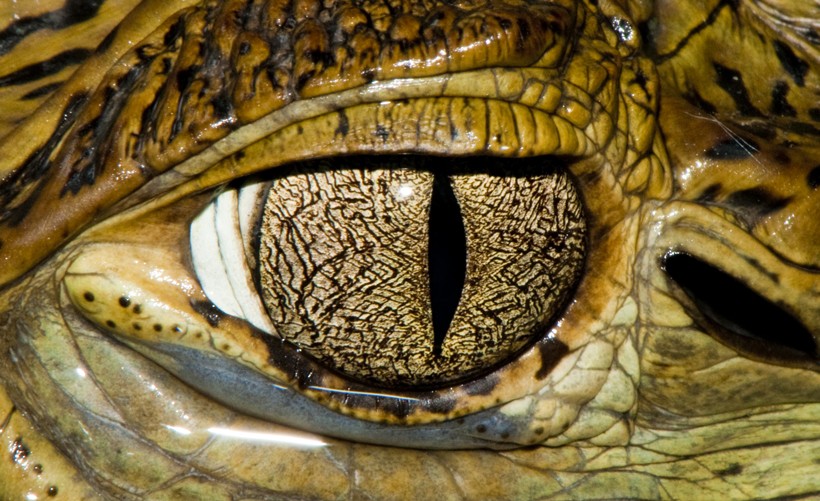
A golden pupil is rare among the normally brown pupilled dwarf caimans
?
Image credits: iliuta goean/Shutterstock
Their head is smooth, short and skull shaped with a distinct overlapping of the lower jaw by the upper jaw. This tiny predator has bony upper eyelids and a heavily armored back that is further composed of sleek scales. The arrangement of scales distinguishes this crocodilian from its cousin, the Schneider’s dwarf caiman. While the post occipitals showcase 2 rows of scales, the dorsal has 18 longitudinal rows and 6 - 10 haphazardly stacked transverse rows. The scales on the tail (single & double crests) contain the highest amount of bones making it inflexible and brittle. The double row of scutes on the tail is arranged neatly, small in size and projected ventrally. A unique feature that helps in differentiating dwarf caimans from other species is the presence of a bony infraorbital bridge that is located between the eyes.
Diet
The diet of a Cuvier’s dwarf caiman depends particularly upon its habitat that can either be aquatic, terrestrial or riparian. While an adult dwarf caiman feasts on small mammals like field mice and terrestrial invertebrates like beetles, worms, and grasshoppers etc, crustaceans in the aquatic food web are also popular prey. Juvenile dwarf crocodilians hunt down crabs, freshwater shrimps, crayfish and copepods found within the South American wetlands. Adults consume larger animals like piranhas, tadpoles, frogs, snails and other crustaceans.
Prey
Cuvier’s dwarf caimans are nocturnal hunters, searching for food at night in forested grounds and nearby river beds. The species can easily detect prey in the water using its scent glands that are present along the lower jaw. The presence of their elliptical pupils gives them binocular vision that helps to target a prey at night and also scan the area. Caimans also spend a lot of their time submerged underwater where they patiently wait for their prey to approach. Integumentary sensor organs present on the caiman’s body that you can see in the form of raised spots are pressure sensitive that allow the reptile to detect movement.
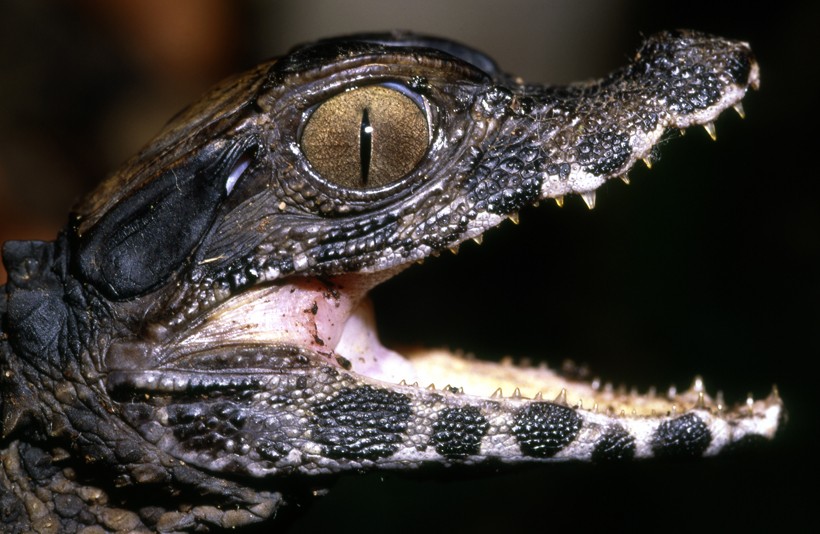
Dwarf caimans have 5 to 15 maxillary teeth on either side of the upper jaw while the lower jaw contains 21 - 22 maxillary teeth
?
Image credits: Dr. Morley Read/Shutterstock
Cuvier’s dwarf caimans are carnivorous in nature that swallow their prey as a whole. Found primarily in the mangroves of South America, this species is also an ambush predator. Their small, curved teeth that are best suited for the intake of invertebrates allow this small crocodilian species to break through hard shells using a strong set of molars. The body of the dwarf caiman is usually murky green with pale stripes or dark yellow that allows it to camouflage itself in the wild. The long frisky tail gives it adequate thrust for swimming away from predators. The gastroliths (stones) present in the gizzard (stomach that maintains a single fold) simplify the breakdown of food and ensure adequate expansion and contraction during digestion.
Predator
Predation is the process of interaction between species in which one species eats the other and playing a vital role in influencing the abundance, distribution and variety of species in ecological communities. In case of a Cuvier’s dwarf caiman, since it is the smallest species of the Caiman family, it is preyed upon by many. The riskiest time of a dwarf caiman’s life is when it is still in the egg. Predators like large rats, raccoons, wild cats and many other carnivores can easily destroy a nest. Many adults are at a high risk of being hunted by large venomous snakes like Cobras and Vipers, non-venomous species like the boa constrictors and wading birds. Few other predators of the dwarf caiman include the Green anaconda, jaguars, herons, opossums, procyonids etc.
Reproductive Cycle
The Cuvier’s dwarf caiman is a social species but very territorial in nature. They can be found alone or in pairs for most of the year but they come together mainly during the breeding season. The breeding of the species is seasonal and takes place once a year. During this season, males are found looking for suitable mates and can often be seen with their heads held high and the tip of their tails jutting vertically out of the water. They release a sound called a ‘roar’ which is a grunt like call to indicate their readiness to mate. The male dwarf caiman mates with more than a single female and copulates at night near shallow waters. The female mounts the male twisting her tail under that of him during copulation which lasts for about 5 – 10 minutes.
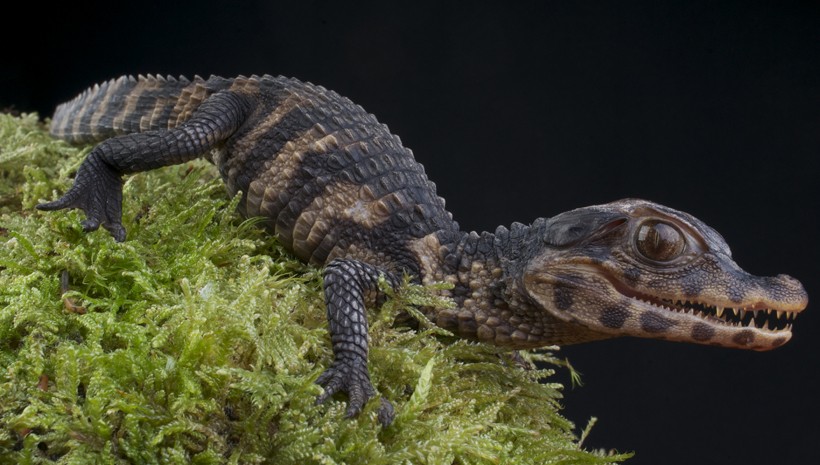
The newborn dwarf caiman is brown and has a black banded pattern.
?
Image credits: reptiles4all/Shutterstock
In areas where the climate is warm, a female Cuvier’s dwarf caiman prefers to nest at the end of the dry season till the beginning of the raining season. Females build their nests using mud and foliage scraps or simply inhabit burrows of other animals. These mounds are built in a location that is safely hidden away from large predators. Males do not stay near the females during the hatching or post-hatching period. They leave once the female lays her eggs within a clutch of 10 to 25 eggs. The eggs are long, white and weight around 61-70 gm. The incubation period is around 4 to 5 months. When the eggs begin to hatch, the female opens the nest thus responding to the calls made by the juveniles.
The sex of the hatchlings completely depends upon the temperature of the nest at the time of incubation. Higher temperatures produce more males whereas females are developed in lower temperatures. A juvenile dwarf caiman is brown all over with a black banded pattern. As they grow, the baby develops a dark coloration of a chocolate brown head and white banded patterns on its lower jaw. The blooming newborns have a thin and protective layer of mucus which protects their body from fungal and algae growth. They remain under the debris staying clear from water for a few days until the skin becomes hardy. The female caiman looks after the young for a few weeks after which the hatchlings scatter.
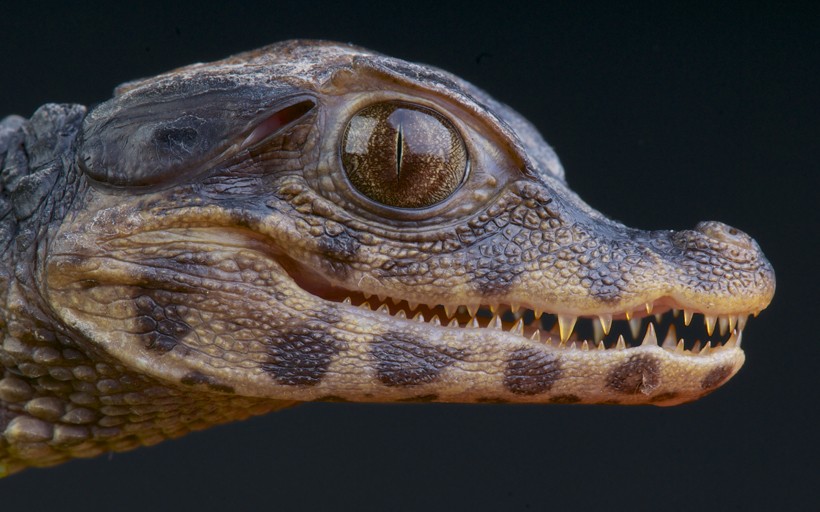
Newborn dwarf caimans stays away from water until the skin becomes hardy
?
Image credits: reptiles4all/Shutterstock
Though parental care is quite less in case of the dwarf caiman, reports suggest that many females stay near the hatchling group for a few weeks. During this growth phase, they remain alert and react to even the smallest movement. They are quite territorial about their nest which is built from soil, rotten leaves, small twigs and other such vegetation. After the dispersal of the hatchlings, the female recognizes the young ones by smell but she rarely returns to the same nesting site. The average growth rate of juvenile dwarf caimans is around 8 to 10 cm per year. Males become sexually mature once they are 1.1 meters in length and females are fit for breeding once they attain a size of approximately 1 meter.
Behavior
The Cuvier’s dwarf caiman is a social species that is known to show dominant traits with regards to its nest or burrow. They are nocturnal hunters that convey messages using movements, sounds, postures, smells and touch. When they are found in pairs, they migrate long distances due to a competition of space or lack of burrows. They are born nomadic, but once they have claimed a particular territory the dominant males defend this space from other males. This space can include access to mates, nesting holes, feeding grounds and much more. The most hostile or aggressive males are the most dominant in the group which is indicated further by social signals or displays.
When threatened, this species inflates its body to exaggerate its size and can hiss defensively although their agile body allows them to swiftly escape their predators in the wild. Communication begins from an early age that is demonstrated in the form of sounds, movements and body postures. Head slapping or jaw clapping near the water surface is a defense mechanism displayed by female caimans when they feel their nest is being threatened. During courtship, male caimans release grunts or a ‘chumph’ like sound by expelling air through its nostrils. Another peculiar behavior is when they expose their head or tail above the surface that indicates the status and intent of the dwarf caiman.
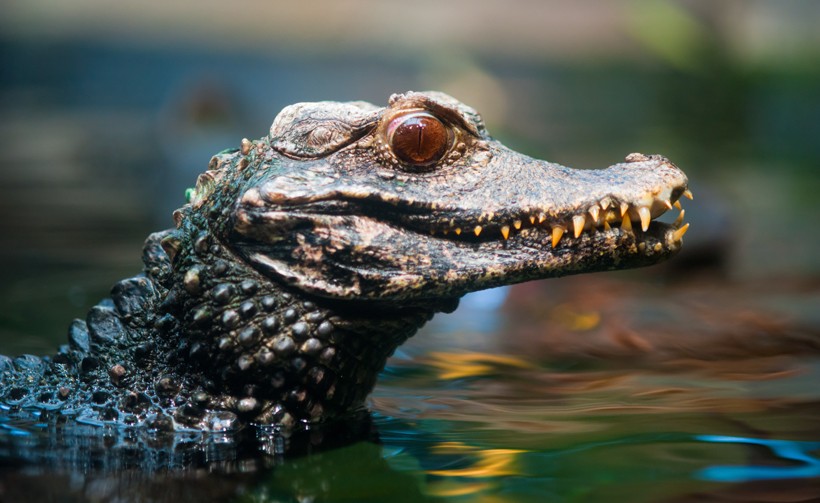
Dwarf caimans expose their head above the surface to indicate their status
?
Image credits: Eric Gevaert/Shutterstock
They prefer to spend their time basking in the morning and begin foraging after the sunset. Most adults occupy burrows that are away from the water for about 1.5 – 3.5 meters underground. Cuvier’s dwarf caimans can cover large distances overland and can often be found near isolated temporary pools. They like to experiment with food and, therefore, devour whatever it comes on their way in large chunks or whole. They are generally noisier than most reptiles, making a series of sounds. However when it comes to hunting for prey, they are also ambush predators.
Threats & Ecological Significance
Many crocodilians are hunted for their skin, but this is not true in case of the Cuvier’s dwarf caiman. This is because the species has a double layer or osteodermis present along the ventral scales, thus making the skin resistant and expensive to tan. Data also reveals that the species is widespread with a stable population. According to the IUCN Red List, the species is considered Least Concern and has been listed in Appendix II of CITES. Though the species is abundant, the population of the Cuvier’s dwarf caiman does face a few problems.
Illegal trade or hunting of Cuvier’s dwarf caiman has become a common trend today but its population has not yet reduced significantly. Pollution caused by gold mining activities, intensive agriculture, urbanization etc are all causes for habitat destruction. One of the most severe problems is mining operations that destroy burrows and nests of the species. Noise pollution disrupts the mating rituals of the dwarf caimans especially since vibrations produced on the ground often cause females to scuttle away from the breeding grounds.
Cuvier’s dwarf caiman is also harvested for producing traditional medicine where several body parts are used for treating certain ailments. In case of rheumatism, fresh caiman fat is used as a natural remedy and the teeth are used in amulets as it is assumed that they provide protection from snake bites. Many indigenous tribes hunt the species for its meat especially in the Amazon forest while in Guyana the species is captured for illegal pet trade. The estimated population of the species is more than a million. However, this can decline as human interference increases.
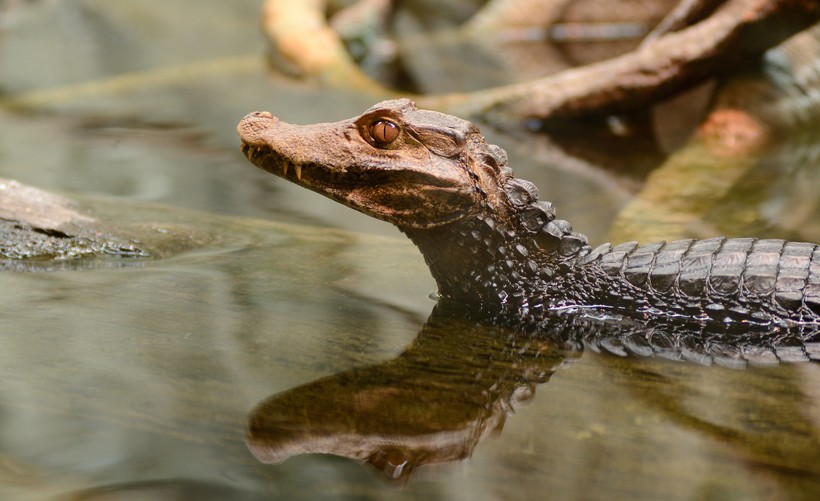
Cuvier's dwarf caiman plays a crucial role at maintaining the ecosystem, rainforest of eastern ecuador
?
Image credits: TFoxFoto/Shutterstock
Dwarf Caiman is known as a “keystone species” that maintains the ecosystem by selective predation. Keystone species refers to species whose absence or presence affects populations of other species in an area. Despite being small in size, Cuvier’s dwarf caiman plays a crucial role at maintaining the population of certain species in the wild like piranhas that can dominate the aquatic ecosystem if their gene pool collapses or capybaras.
Funfacts
- Cuvier’s dwarf caiman can swim at a speed of 30 miles per hour.
- They can survive up to 60 years if bred in captivity or as pets.
- When they dive underwater, they close their nostrils, throat and windpipe to catch prey underwater easily without facing any risk of drowning.
- Gender of the eggs is determined by the temperature during early stages of incubation.
- Cuvier’s dwarf caiman is the smallest of all Caiman species.
- A caiman does not shed its skin regularly but periodically sheds each scale.
